Introduction and summary
This article explains how sociocracy can be used to form multi-layered organizations – for example, organizations with national, regional, and local chapters. The challenge in this kind of organization is the fact that, oftentimes, the different layers or pieces don’t fit well together, either because there’s a lot of doubling of structure (the same work done on chapter and on national/regional level but not well connected), or there’s a lot of time spent on meeting in large assemblies which often just scratch the surface and aren’t really useful for the concrete work of each individual chapter.
In this article, I will show how sociocratic circle structures of small, nested, linked circles can connect while keeping each group and each meeting meaningful while making sure information and services can flow through the organization. In addition to standard sociocratic tools of linked circles, this article also makes use of two additional tools: the function of a help desk and the function of a community of practice.
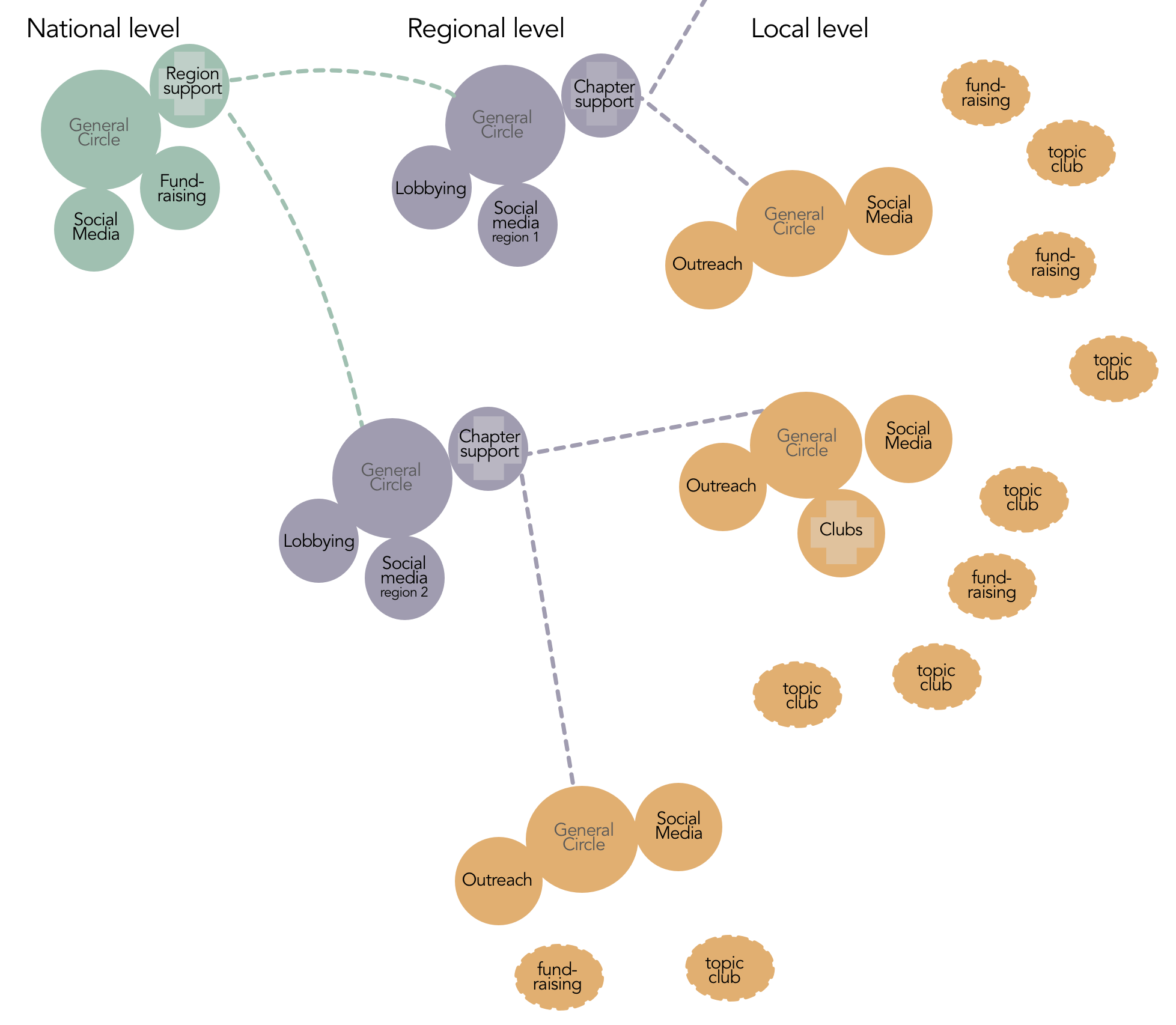
Table of Contents
The challenge
Most national organizations that I am aware of have some doubling of geographic focus and topical focus. It makes sense to have each topic represented in all regions, but also all regions in the headquarters and on intermediate geographic levels. Yet, if we do that plainly, we run into issues when there are several levels of the organization that are the same or that only differ in one feature that doesn’t directly affect their work. For example an organization with the aim {aim} that has subcircles {aim1}, {aim2}, {aim3} and operates in different countries {country1} and {country2} and {country3}. Which of these patterns would make the most sense?


As they stand, neither of them seems to make sense. It’s clear that people working on the same should be connected, while people in the same country should also be connected. Yet, within the regular sociocratic structures, that’s impossible.
One would think that it’s easy to draw additional cross-connections like in these diagrams:
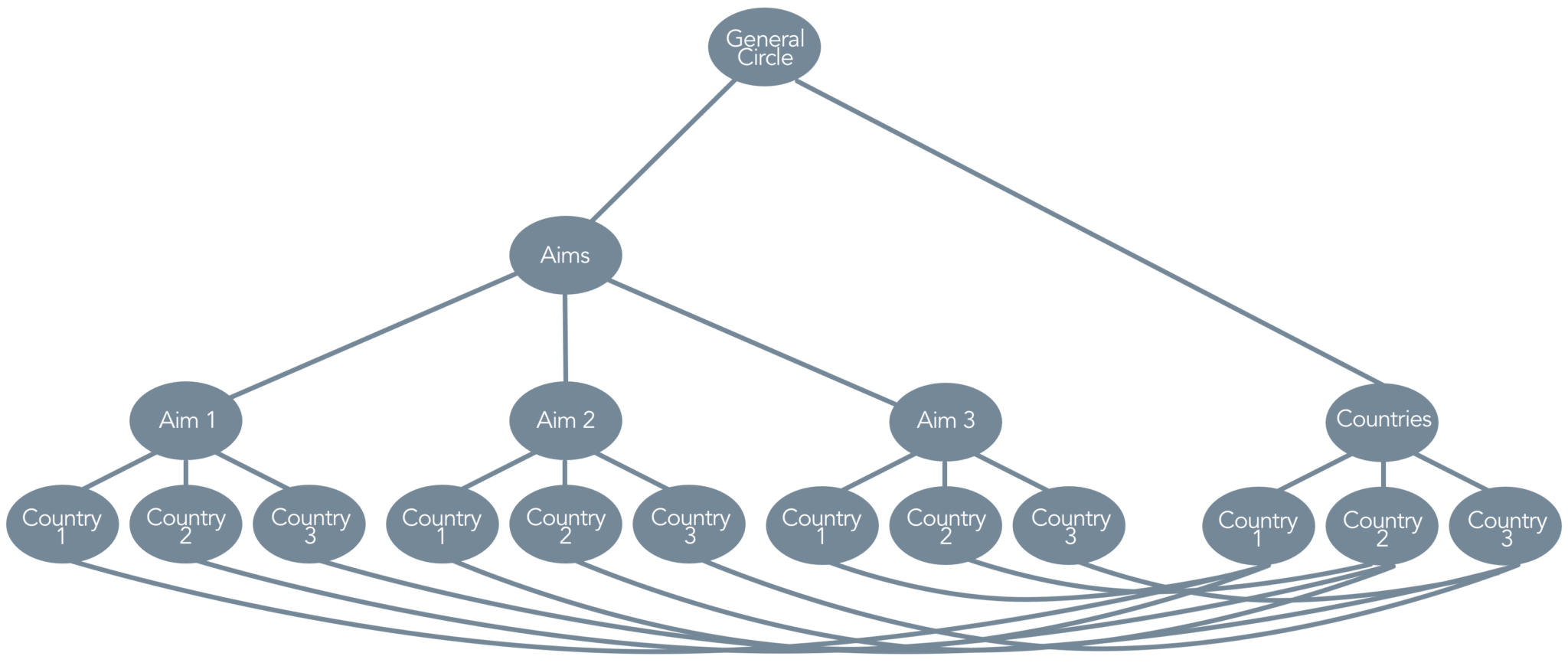
Yet, while that looks elegant, it doesn’t solve the problem – instead, it turns the organization more rigid and shallow at the same time:
- The strength of sociocracy structures is their clarity and flexibility – any circle can negotiate how its sub-circles divide up their aims. Now if the sub-circles chunk {aim1}, {aim2} and {aim3} in a way that’s different from one another, let’s say {aim1a}, {aim1b and 2b}, and {aim2a and 3}, the whole system structure of connections just falls apart. Just think of what would happen if the countries have sub-sets that speak different languages (like if part of the Belgium Circle, based on language, belonged half to the Netherlands Circle, and half to the France Circle, but not for political topics). Reality is too complex and messy to fit into a neat system like in the “cross-linked” structure.
- Yet, freezing the subcircles in place (i.e. not allowing them to form sub-circles, or only sub-circles of a particular, uniform kind for each region) is a big tradeoff, reducing the sovereignty and therefore the effectiveness of the circles. For example, it would mean that each country would have to divide up the aims in the exact same way and would need to have a cookie-cutter sub-circle system. This comes out more like an imposed franchise than a self-governed, semi-autonomous system. It might work in a strictly top-down organization that builds local chapters – but it doesn’t mix with decentralized organizing.
- In building cross-connections, we’ve now also added a layer of complexity, as now it’s a 4-tier organization. From experience, in this system, it would be hard to keep the conversations relevant on all levels, but especially on the intermediate layers. If we connected the Aim1-Aim3 circles with the Countries circle at the General Circle, we would have very different needs at the table. It would always feel like a fragmented conversation. The more fragmented a group is, the more shallow and less relevant its conversations will be. Think of an intermediate layer where some want to talk about their social media campaigns, some about fundraising on a global level, some about training events, while others want to talk about what it’s like to be a chapter in France vs. in Italy. Additionally, with each additional country, the group size in the meeting would grow, turning into large assemblies where meaningful conversations are less likely to happen.
In a word, while it seems to make sense at first, the structural disadvantages are just too many.
Design principles
The structure in this article provides a way out and creates meaningful intermediary layers to keep group sizes small while connecting all players in a useful way.
This section establishes the design principles that will then be plugged together later in this article to build a flexible and robust system.
Circles
In regular sociocratic circle systems, there are different circles.
- Work circles. Work circles hold a domain in which they make decisions, and they do work in that domain. A domain is the area of responsibility of a circle. By packaging authority into domains and distributing them within the organization, circles are empowered to make decisions on their particular piece of work. (See more information about domains in decentralized organizations.)
- General Circles. In the center of different circles, there’s a General Circle to make sure that all domains are aligned, and all circles have a place for mutual support. Ideally, a General Circle doesn’t make decisions about the work but rather decisions about domains – deciding who decides.
Gatherings/communities of practice
There are groups that are not circles. For example, an all-member meeting might be a group that meets but doesn’t have a domain because there’s nothing this group of people decides. For the same reason, a mutual support group (like a book club) is also not a circle because it doesn’t make decisions beyond the scope of its own group. We call these groups communities or practices or gatherings. (See more on communities of practice and gatherings in the context of sociocracy in our handbook Many Voices One Song.)
The absolutely crucial part to understand here is that what makes the difference between a circle and a gathering is whether or not the group is responsible for the domain of the whole organization.
- For example, the decisions a book club makes together (like, what books to read) do not affect any circle outside of the group. It’s a gathering or community of practice because it doesn’t have a domain. For the purposes of this article, I will call those groups communities of practice (CoP). In the example of a book club, the book club for itself makes decisions about what to read and how often to meet but this never extends beyond itself. For example, they don’t make decisions about which books should be read by other people. They are a self-containing, self-organizing, one-cell entity.
- By contrast, the decisions a Social Media Circle makes, do affect the whole, and their decision-making extends beyond just themselves; they are taking responsibility for a domain within a bigger part. Therefore, it’s a circle.
If an official circle is formed that explicitly holds the decisions in the domain of the organization’s social media outlets (like, what do we want to sound like as an organization, how much money do we want to spend in that area, etc.) then that domain is claimed and can’t be stewarded by different groups at once. (Unless they are taking care of different social media outlets, and we’ll get to that!)
A good tell-tale sign to distinguish between circles and CoPs – which will be relevant later – is whether or not a group could just be cloned with other members in it without issues. For example, if a book club gets cloned with other people as members (same books, same Tuesday evening meeting), there’s no issue. We could have thousands of book clubs reading the same books and having the same discussions. Yet, if there are just two Social Media Circles that take responsibility for identical social media handles (for the same organization) but are a completely different set of people, it’s likely that there will be conflict, for example, if one group changes the settings or the password on the other circle.
Help Desks
Let’s introduce another category that will be useful in support of this topic: Help Desks. Help desks are circles that have as their aim the support of other circles to do their work. While every circle does that to some extent, a pure help desk only does that. An example could be a designated circle that helps other people with tech questions – but doesn’t do tech work themselves. Or a circle that provides legal advice, or an in-house graphic designer or printing service.
Not every organization will have a Help Desk because it’s costly to provide in-house support service. Yet, an organization of a certain size often specializes and provides those internal resources, which can be in particular helpful in large volunteer organizations. A Help Desk might be more reactive (more like an in-house consulting service) or it might be more proactive (like in making a repository of press release templates). The whole point is that they are other-focused.
Connected functions
I think of these three different functions of groups as the ingredients (together with Listening at Scale) that we need in order to plug together a system that combines networks with organizations.
- A Help Desk is focused on supporting other circles in doing their work.
- Work circles: circles doing work and making decisions in their domain.
- Communities of practice: Circles that don’t have a domain on their own but support conversations about the topic.
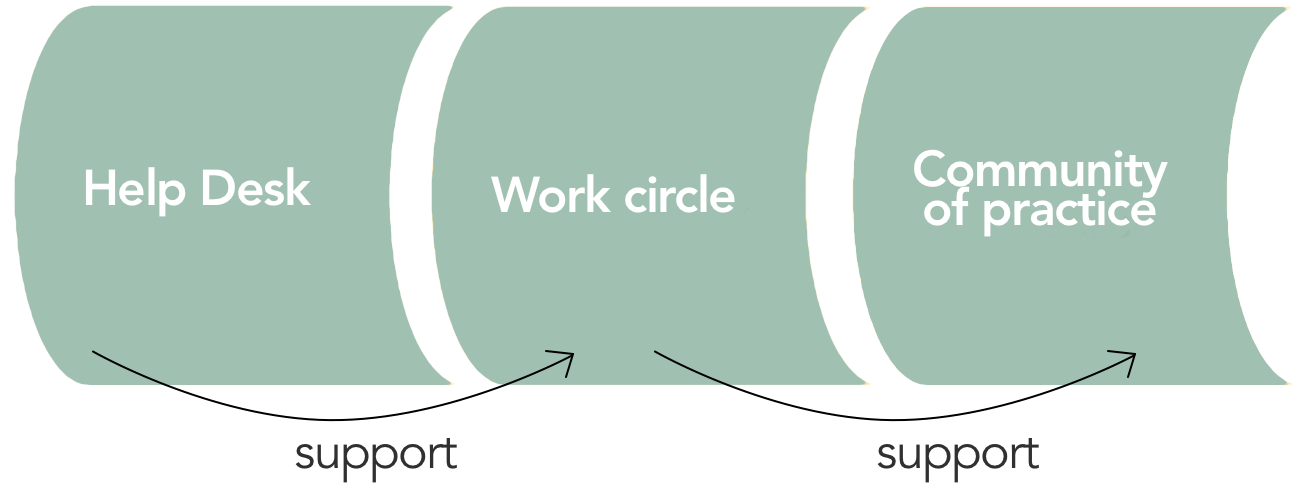
You may notice that there’s an organic order to the three: imagine a work circle with the aim of supporting restorative justice in schools. The Help Desk might be a circle that supports restorative justice work circles in different sectors, helping them curate and publish their articles, and supporting their webpage on the topic. The Work Circle itself is working on writing articles and organizing events and training on the topic. A Community of Practice might form between restorative justice practitioners for exchange within the group. There might be more than one Help Desk that’s relevant to the work circle (maybe one for graphic design, one for IT support), and there might be more than one CoP connected to the topic. The Help Desk is supporting the work, the Work Circle is doing the work, and the members of the CoPs are giving each other mutual support in their practice.
Another example: Let’s say we have an organization that wants to lobby states to change their policies in the education system to better fund public schools. In a country where government decisions on education happen at the state level, the working groups will have to act at the state level. Yet, on a national level, there could be a Help Desk circle that supports the work circles, for example around legal advice, or by providing them with free, in-house advice for fundraising. On a state level, the work circles write bills they want to pass and they do all the networking, etc. as part of their lobbying efforts. Some regions might have CoPs that gather and talk about their experiences, and bounce ideas of what could be done on the state level. This example shows well how, ideally, they all are associated with each other in some way – they know how to find each other. But their group purposes are distinct.
Hybrids
This is not the whole picture yet. For full flexibility, we also have to take into consideration hybrids of help desks, circles, and communities of practice.
- Help Desk and Work Circle: a circle can function as a Help Desk and be a work circle at the same time. For example, let’s say we have a national organization for youth work with local chapters. In this example, Social Media Circle would run the national-level messaging with the national Twitter account/website – that’s the work circle aspect of their work. But they also serve as a help desk by providing help to chapters or regions in writing press releases – that’s the Help Desk aspect of their work. They are doing double duty.
- A group can also be a Work Circle and a Community of Practice at the same time. For example, think of a group of practitioners of restorative practice in schools who, from time to time, also write case studies and publish them. If they, in their organization, own the domain of restorative work in schools, they could be a circle while spending a part of their meeting time just supporting each other in their own, individual experiences.
(I cannot think of an example where a group would be a dedicated Help Desk and a CoP, or all three functions together, Help Desk, Work Circle, and CoP. That doesn’t mean it’s impossible, just not as common.)
Different functions on different levels
Let’s recap. We know that there are three different functions: Help Desks, work circles, and Communities of practice. We know that they fit into each other because each level supports the next-”lower” level in its own way.
Those levels may be mapped onto national, regional/state, and chapter levels. The example here would be the example from above where a national level supports the infrastructure and expertise like templates and a website to support regional work circles that produce articles on state developments that inspire and guide local support groups (CoPs) where members support one another.

Yet, a group can at the same time hold several functions (hybrids). In hybrid 1, the blueprinting for satellite writers happens at the same time as original content production in the circle; while CoPs still only meet for mutual support. In the hybrid 2, there’s a national help desk to support publications, while local chapters write on local topics, and meet for mutual support.

It’s not a given, however, that the national level would be a help desk level or that the regional level is the work circle. It might be that there’s a work circle on each level, just for distinct domains.
Let’s say the organization owns Twitter handles @XXX_national (national), @XXX_California (state), and @XXX_LosAngeles (local). In this situation, we might have hybrids where each level is a work circle, each doing work in their domain.

Let’s assume that the national level work circle has people working who are professional full-time staff. While their work circle function is to post as @XXX_national, they also have extra time and expertise to help any chapter or state level, for example by teaching classes in social media literacy and curating an info page with all the helpful resources. That makes them a help desk.

Maybe there are actions that the state-level Social Media circle does, for example, planning campaigns that apply to the state level. In that case, they might support local chapters in doing their own local campaigning by providing a stop-the-pipeline campaign blueprint.

The patterns might evolve, expand, contract, shift, and be fluid over time. While work might stay constant, Help Desk functions can be added when there are needs and capacity, just for the time frame of a campaign, or long-term.
There could be several CoPs and other work circles helped by the same Help Desk.
Now we’re going to add one more level of complexity needed to build a meaningful national structure: we need to imagine an organizational structure where all of those different functions can be distributed independently and differently for different parts of the work. For example, for social media, we might have a structure where the national level is a help desk, while for fundraising, we might have the work circle on a national level. For direct action, the work might happen on the chapter level while the legal advice is offered on regional and national levels. It is a key ingredient of a meaningful structure to figure out what domain is best-taken care of on what level and in what way. The basic question is always: who is working on what, and in what function?
Below is an imaginary organization where the actual work circles are in bold font and the Help Desks and CoPs are regular.
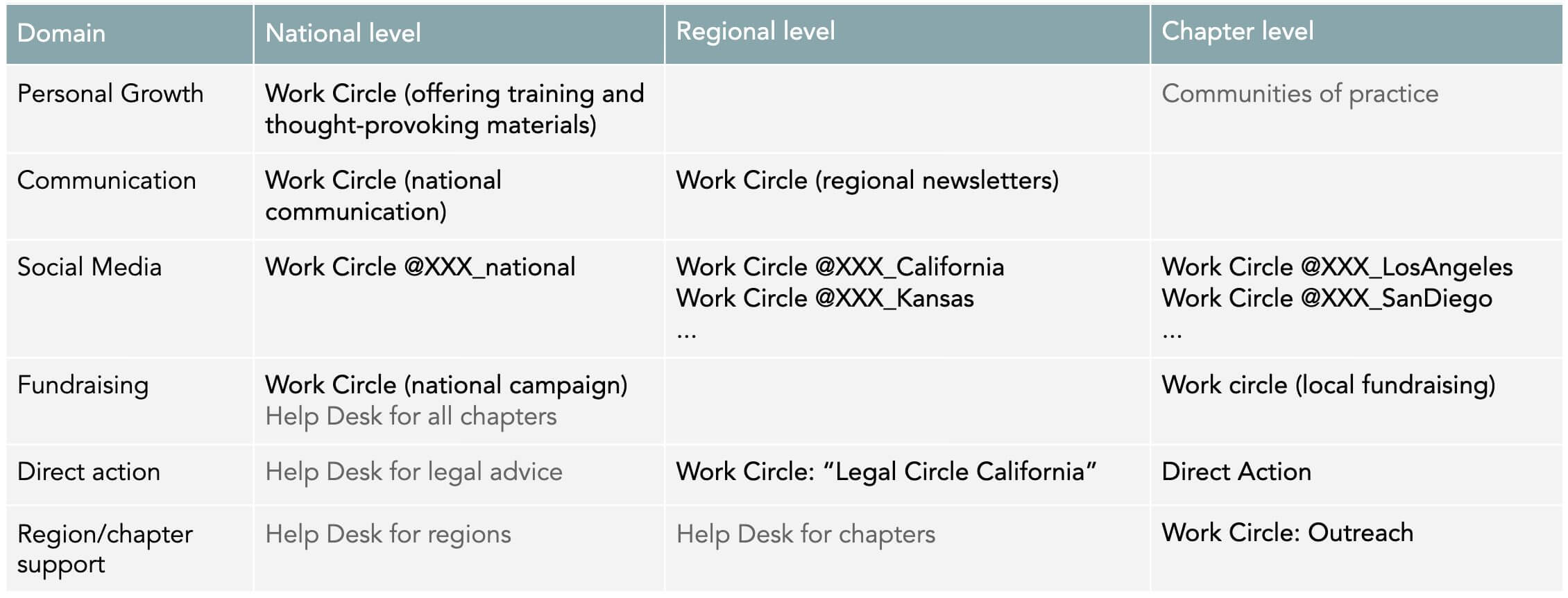
Now designing a multi-layered organization is “just” a matter of design – designing where work circles take care of what domain, where communities of practice form to give mutual support, and where the organization wants to (and can afford to) position a Help Desk to support work circles.
Note that this kind of table charts the authorities and functions (aka domains and aims) of the different circles and gatherings, not the flow of information or linking (yet). We will add that later. For a solid foundation – and to reduce the doubling of circles or empty, intermediary layers – we need to focus on domains. While aims describe what circles do (like “messaging on social media”), domains describe what a circle has authority over, and that’s where much of the differentiation happens. For example, in the above table in the row of “Social Media”, each level might have as its aim “messaging on social media” but the domains are different because they own different handles with different scopes.
The domains can be symbolized like a comb. (This image doesn’t show Help Desks or CoPs – it’s just a way to illustrate domains of work circles.)
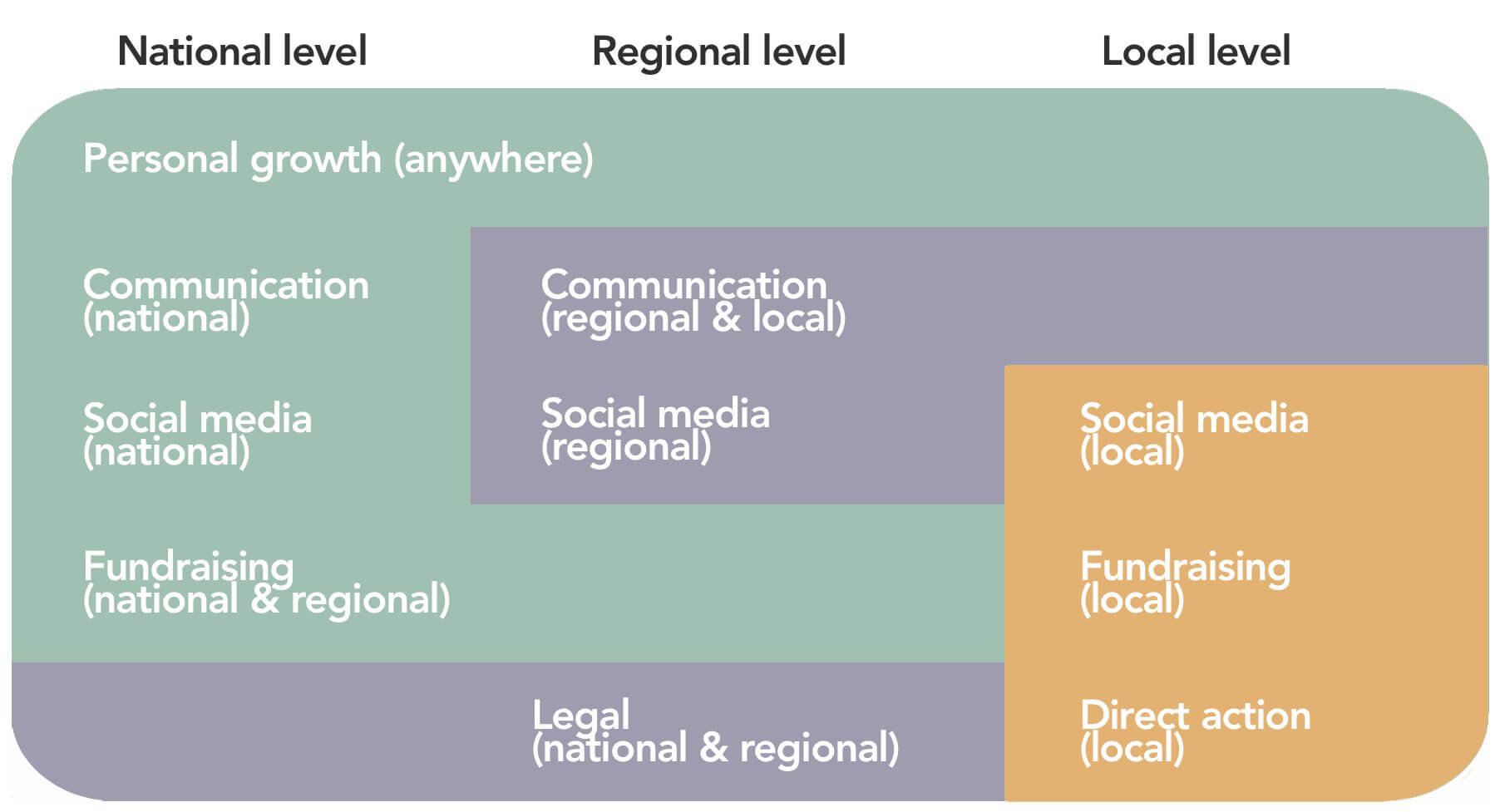
Sub-circles and sovereignty of each entity
All domains need to be clearly defined. Different levels might pay attention to very different things. In this example, the local levels focus on social media (local accounts), fundraising, direct action, and outreach for their chapter, while the regional level pays more attention to communication, regional social media, and legal support. The national level is providing high-quality information on personal growth, national communication, national social media channels, and fundraising support. Everyone is active on the level that makes sense for them, and every topic is taken care of at a level where that makes sense.
You see how each entity looks a little different – that’s just their own style of dividing up and clustering the work into domains.
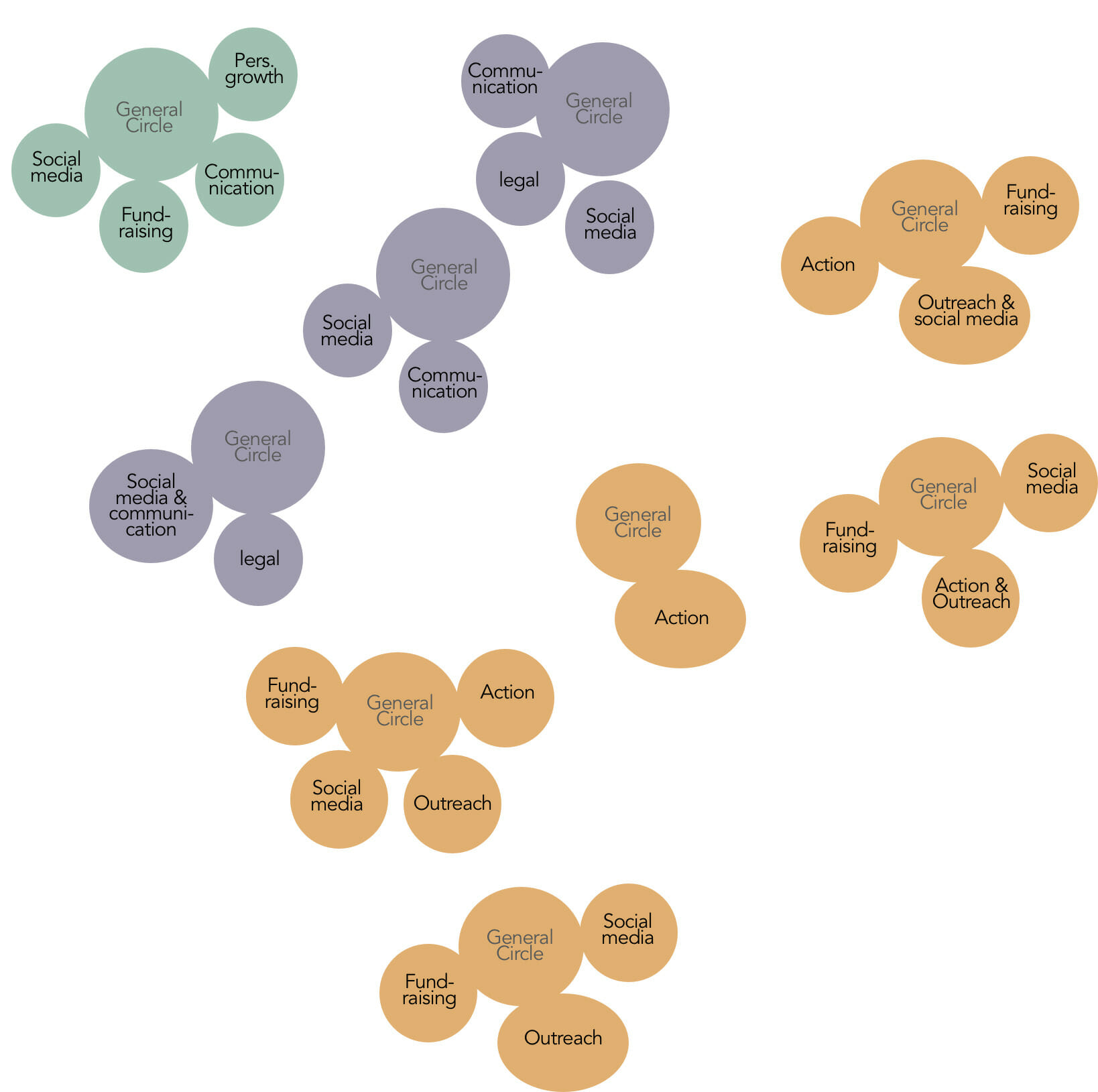
Domains (and aims) are likely to change over time – that “perfect fit” will have to be re-negotiated over time, as national offices and/or local chapters mature or thin out over time. For example, an organization might start with a Help Desk and work circles and then grow at a more grassroots level, or it might start with communities of practice that then form more of a transregional structure. It might have just one national social media circle and then “bud out” and pass on part of its domain to other circles.
What I mean by that is:
Splitting domains into sub-circles (all same level)

This is simply decided locally and can be changed locally.
Splitting domains into regions

Yet, in the structure that I am proposing, there will be no linking relationship (in the strict sense) between “National Social media circle” and “Social media circle region 1” and “Social media circle region 2”. So let’s look at the overall domains and domain shifts between layers.
If a domain shifts from a sub-circle on the national level to a sub-circle on the regional level, it can’t just shift from sub-circle to sub-circle. While it will most likely be negotiated there, that “piece” of the domain has to be passed on to the regional entity as a whole, and from there, it gets distributed. In this way, each entity (region, chapter, etc) is “encapsulated” and autonomous but interdependent with all the other pieces. The issue that is described at the beginning of this article is solved that way: each chapter or region might divide up things a little differently – it’s not a cookie-cutter franchise that has to organize internally in any particular way.
Communication between circles on different levels
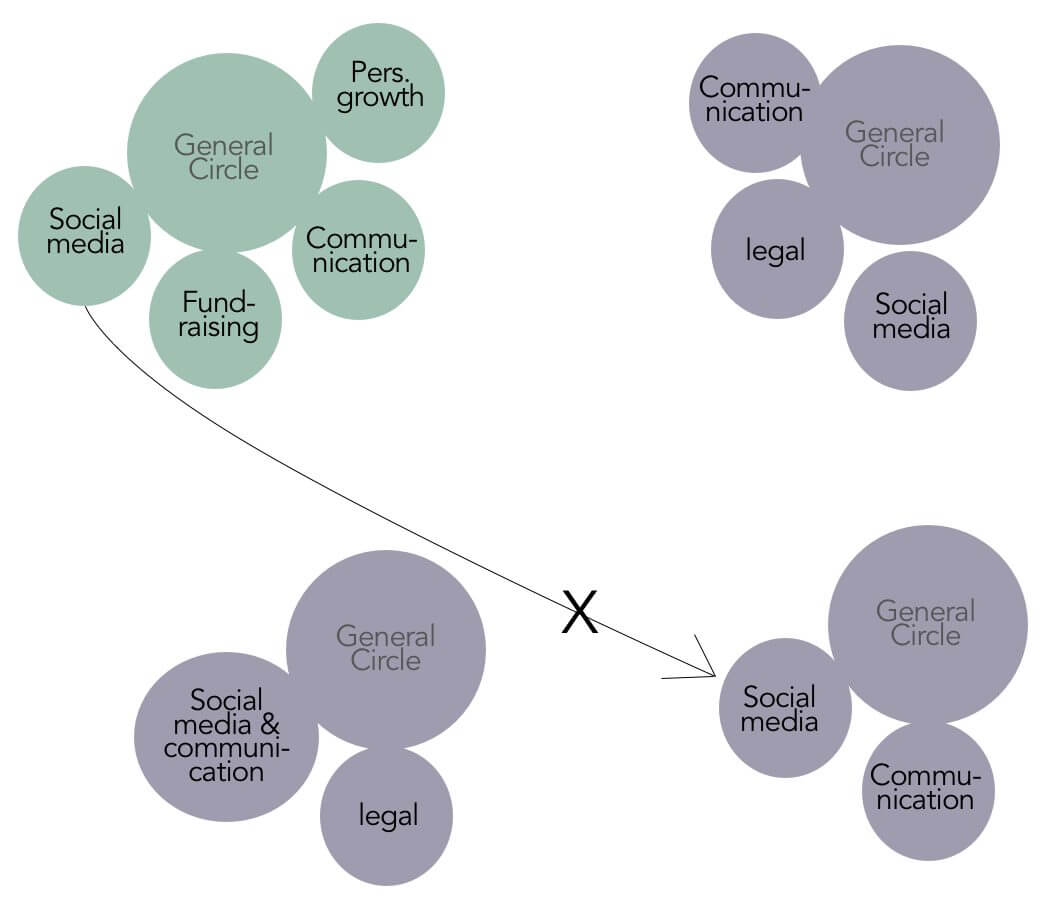
It is clear that in this kind of system, communication will be key to supporting each other and finding synergies in our work. So, while, for example, each social media domain (national, regional, local) is handled autonomously, it still makes sense for members of each level to talk to each other to align efforts or create synergies. This doesn’t have the form of a policy (policy can only be made within an entity) but is more of a voluntary obligation between layers.
Communication can have different forms. For example, this could be a shared meeting once in a while, or a meeting of leaders, 1:1 meetings of the “higher” level circle and a “lower” level leader, it could be talking in a shared forum or live chat just for this purpose, regular broadcasting and/or naming a specific point person and a regular schedule that makes it more manageable to be and stay aligned.
This kind of organizing of domains has real implications: in this example, a coordinated social media campaign by all chapters, regions, and national organizations would only be possible on a voluntary basis. Building in this way means that the national organization cannot rule into the regional or local organizations in a non-consensual way. This means that inspiring people instead of mandating people, hearing their input, and co-creation is key to aligning efforts, not coercion or top-down structures.
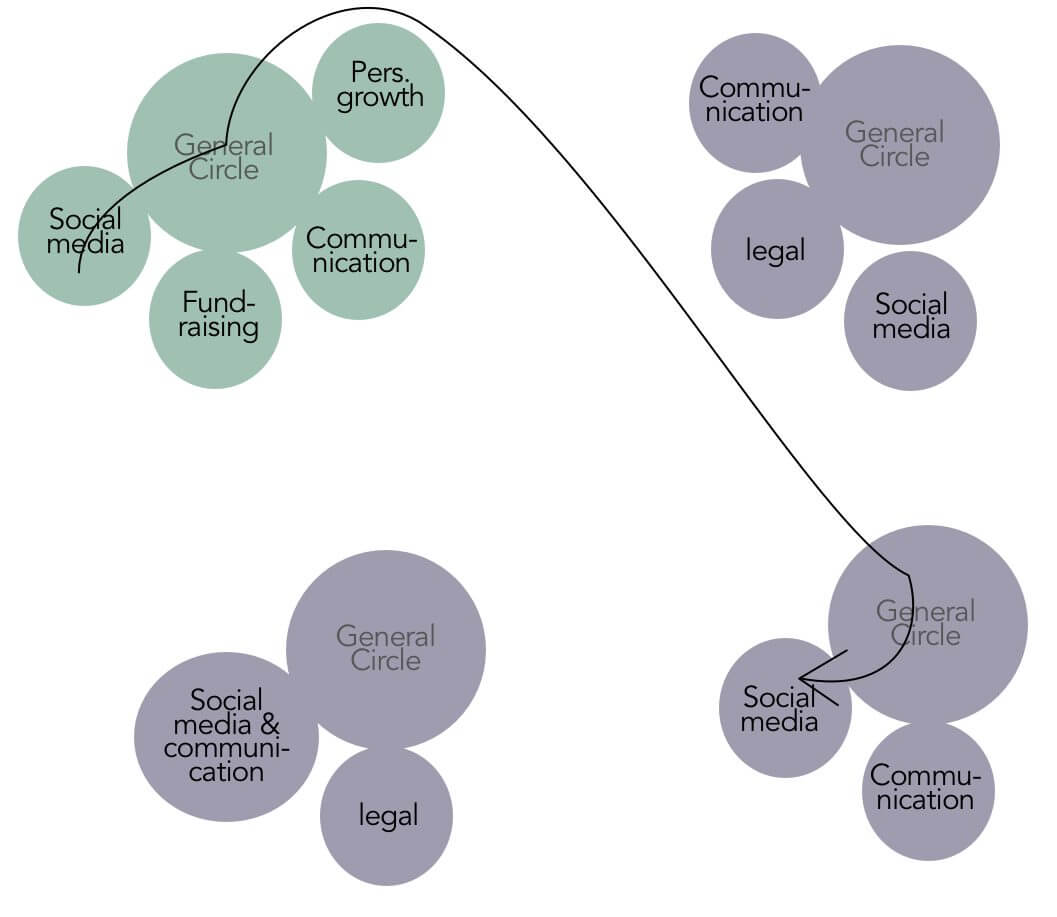
Communication between Help desks and circles
As mentioned above, a help desk function will only be feasible when having an extra level “above” the work circles can be sustained. That said, communication will most likely be push or pull, and the ideal line of communication needs to be designed given the numbers and nature of the work. It could be as simple as a hotline that’s only for members and that’s paid for by the level of the help desk, or an open office hour, meetings by request, or more involved, standing meetings for hand-holding.
Communication with/among communities of practice
Communities of practice (CoPs) can have many shapes – loosely structured groups, open calls, and gatherings all form the networked relationships that add substance to our organizations. Remember that the definition of a Community of Practice is that their purpose is typically self-focus; they don’t take care of a puzzle piece (domain) of the organization but their meetings primarily serve the members. Simply said, nothing crucial breaks if they don’t meet. That’s different with a circle – if the finance or outreach circle stops meeting, a piece of the organization doesn’t function anymore.
While circles and their domains form the skeleton of the organization(s) by providing clarity of who decides what and who has to coordinate with whom, CoPs are free and fluid. For example, a group of people might consist of people who have young children, people who speak Portuguese, people who are new to the organization, second-generation immigrants, transgender or gay, people of color, white people who care about anti-racism, or people who have time on Fridays, people who want to talk about parenting or sets/intersections of different groups. Each conversation between people weaves the web that helps us do what we do.
Any way to get people talking helps. Work circles might host open talks or might curate and facilitate platforms where people can talk. They might send out information to promote certain topics among all groups, and they might help new members get oriented and find groups.
Connections between levels.
Let’s look at an example of how these different domains and functions can be combined.
Below is a slightly simplified version of the example above. The domains/circles in the different topics are spread out over the national, regional, and local levels:
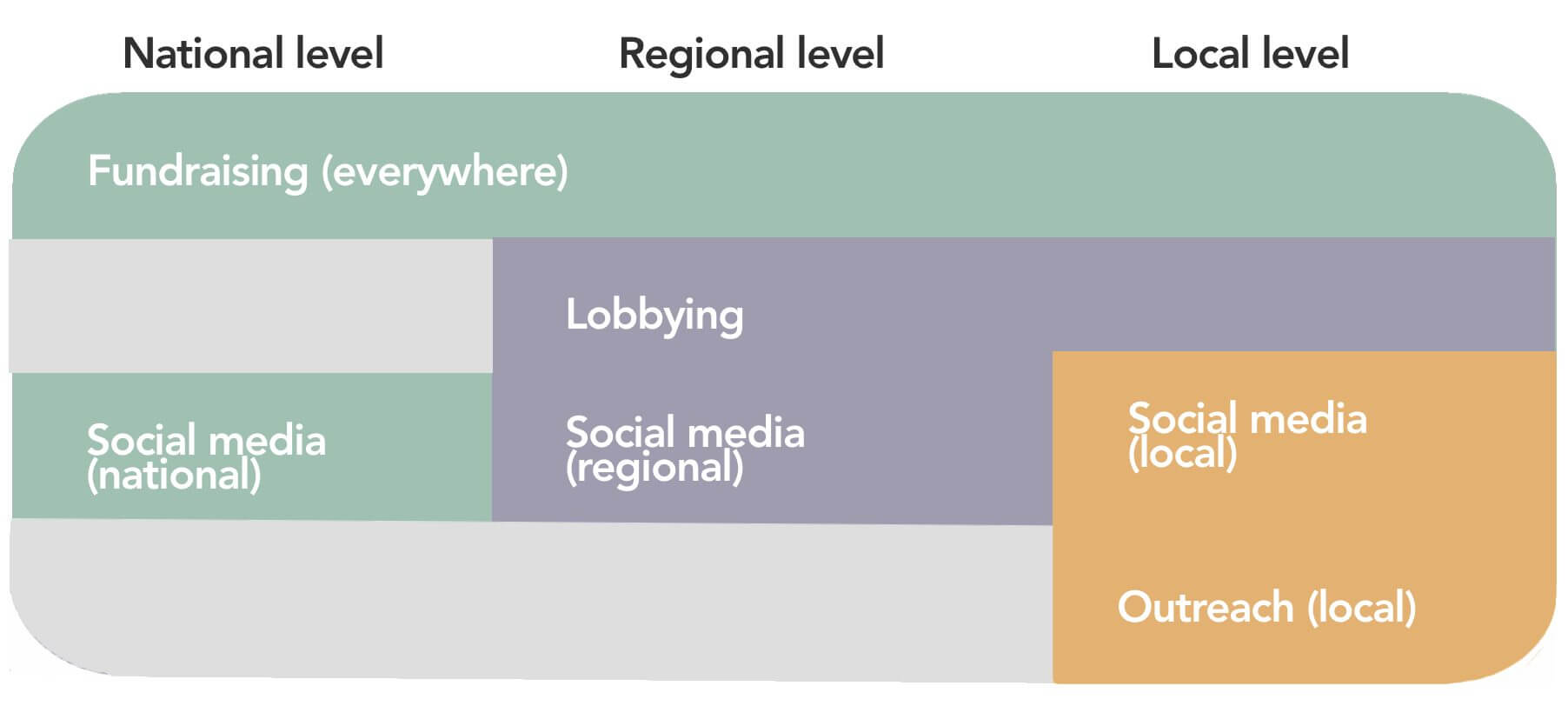

An intriguing connection now falls out of the system: the connection between levels could come in the form of a Help Desk. Let’s say the organization adds a Help Desk for regional circles on the national level and a help desk for local chapters on the regional level. They also add a help desk for local outreach efforts (e.g. a blueprint for outreach materials as well as a national listing so new members can connect with chapters close to them).

Next, let’s assume there are some local fundraising groups that fundraise as part of the national campaign. They are not decision-makers but might be part of open info calls for people who help fundraise etc. In addition, while lobbying happens on a state level, there might be Communities of Practice that talk about some of the issues the organization is lobbying about. Some groups are national open calls, some are local, in-person groups.
Not all chapters or regions are the same. For illustration purposes, see how Chapter 2 decided to offer a Help Desk for local discussion clubs.
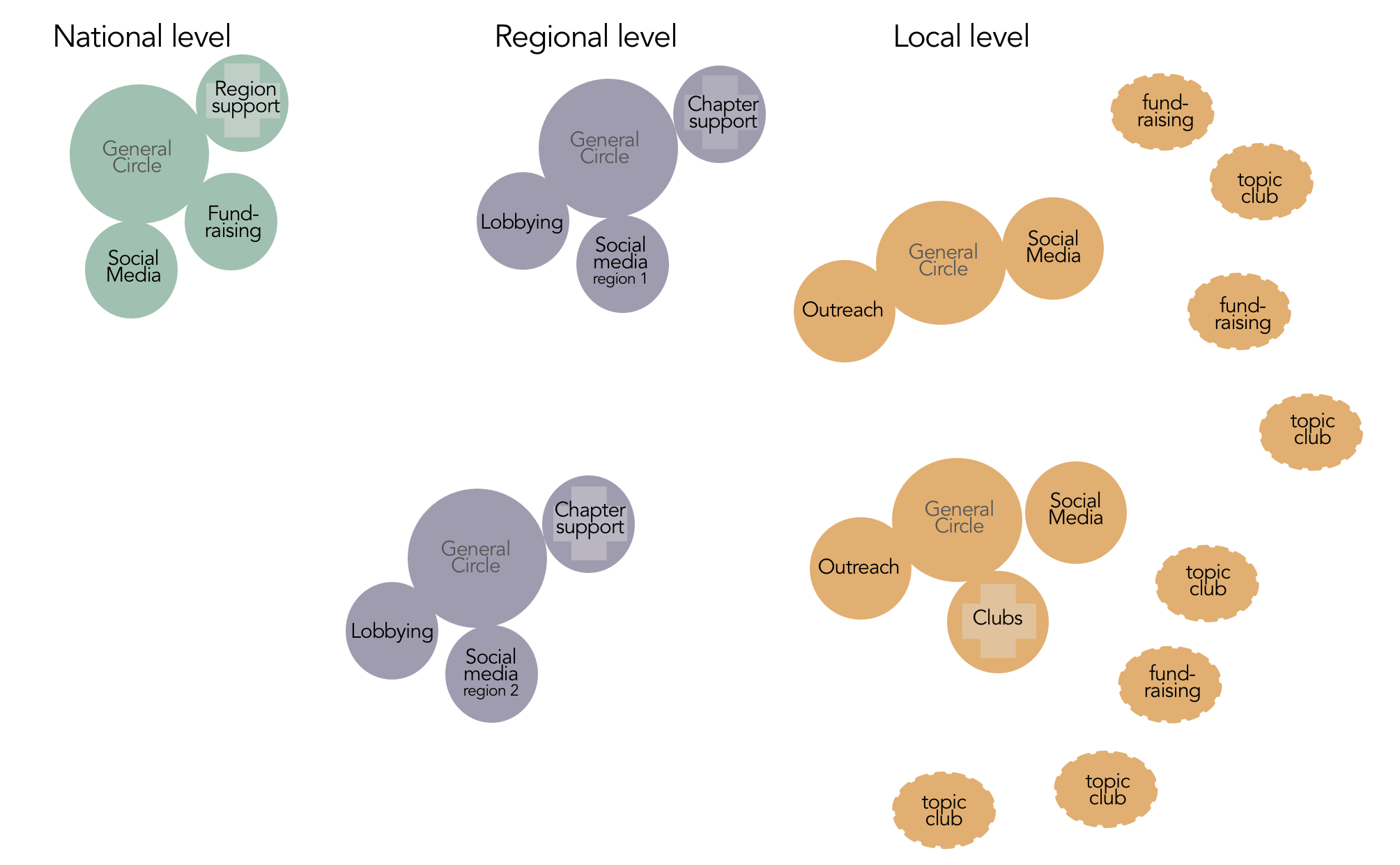
Let’s add communication lines to the picture.
- Help-Desk/”client circle” relationships are dotted lines.
- Communication between layers will happen as needed/invited and isn’t shown. A Help Desk can serve as a connector or listen at scale; it shouldn’t be necessary to meet with all related circles on a regular basis as a decision-making body since each layer has autonomy in its domain. To cross-pollinate, each chapter can get feedback or get to alignment using methods of their choice (see this article Sociocracy meets Listening at Scale) but it’s not required to have every chapter represented to move forward.

Note: In writing this article, I was aware of all previous knowledge required to understand this article, for example on General Circles; some aspects are left out for simplicity, like linking and Mission Circles. Definitely read about domains, Listening At Scale, and review organizational structure in general. This article is intended to show some design principles needed to have a meaningful multi-layered organization. The specifics and communication lines as well as links will differ depending on the organization’s needs.
Do you need help in thinking through whether these design principles would work for your organization or movement? Talk to me: [email protected]. See coaching fees.

